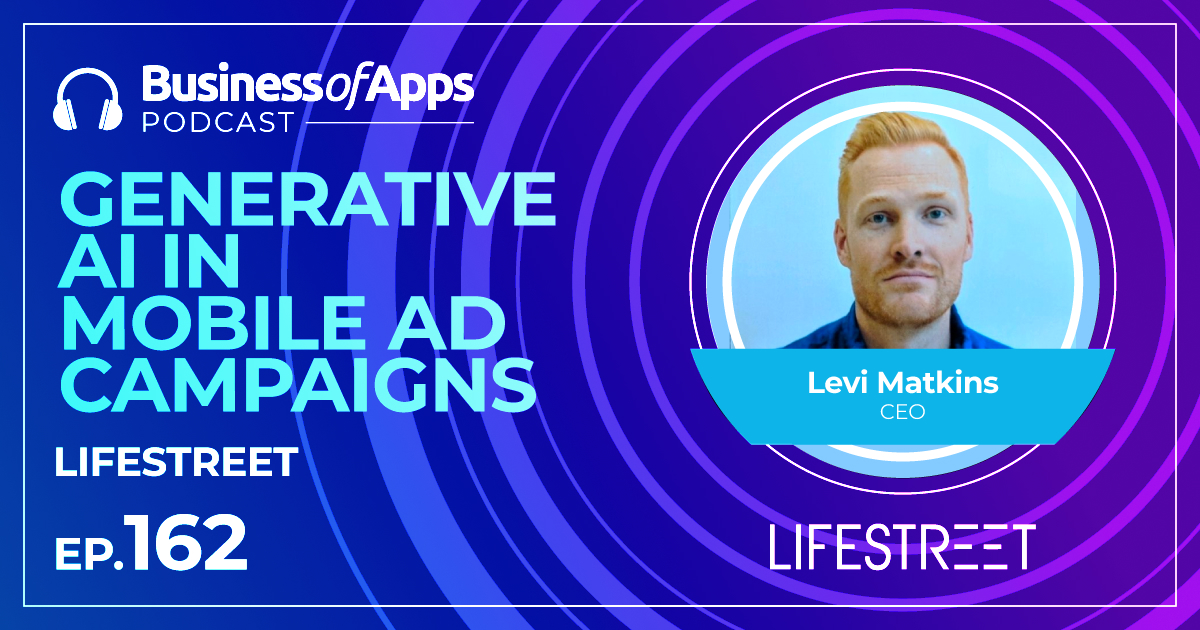The rapid rise of Generative AI, driven by titans like ChatGPT from OpenAI, Bard from Google, Llama from Meta, and other large language models (LLMs), has undeniably become a force to reckon with in today’s digital landscape. Our CEO, Levi Matkins, was interviewed by Artem Dogtiev at Business of Apps to discuss the transformative potential of Generative AI in mobile ad campaigns. From its potential to scale ad content creation to its impact on jobs, Matkins provides insights on how AI will reshape mobile ads, digital advertising, and the world at large.
Generative AI is a powerful tool for content production
Overall, generative AI can powerfully support both ideation and production when it comes to content creation. “With the right guardrails and oversight, [generative AI tools] can really change the way we interact with technology,” said Matkins. As an example, Matkins mentioned how LifeStreet uses generative AI to scale the creation of certain ad elements such as creating voice overs for video ads. While one day this could supplant a design team, at this point, human revision is still very much needed.
Using human development as an analogy, generative AI tools are still very much at the toddler stage. As pointed out by Dogtiev, just as you wouldn’t trust a toddler to run your business, you wouldn’t expect a toddler-age generative AI tool to replace a mature team’s functions. This recognition of generative AI’s early functionality can be seen in the way tech giants currently apply the technology. For example, in Meta or Google Ad Managers, generative AI can be used to power text generation and smart image cropping, but is not available to comprehensively create all elements of an ad from a simple prompt.
There are ways to use LLMs to enhance programmatic advertising functions like bidding
Even in their early state, LLMs can be used to help predictions. As noted by Matkins, LifeStreet is currently using Chat GPT for data augmentation. For example, there are hundreds of thousands of apps that we can bid on but outside of app categorization, it’s hard to find connections between apps at small data sizes for a campaign. We are using Chat GPT to tag characteristics about apps from our own app database that can generalize across those apps with small data sets.
Generative AI will cut costs
Generative AI can certainly help cut costs on the creative production side. “Most content creation — not just in ad creatives but writ large — is going to approach zero as an incremental cost soon,” said Matkins. With the cost of creating content coming to zero, companies will be able to pass that cost savings down their supply chain.
At present, it seems there are two approaches companies can adopt to save costs with generative AI: undertake the same activities at a lower cost, or massively increase output at the same or marginally lower cost.
Generative AI will likely shrink teams
“Historically, we haven’t seen real displacement from technology,” said Matkins. He noted that in previous technological evolutions — like, the shift from horse drawn carriages to cars — individuals who made horseshoes may have lost their jobs, but in the long term, more assemblymen and mechanics were hired to build and service the cars.
However, Matkins sees generative AI having a different effect with work activities approaching a point where less human labor will be required overall. “I don’t at the moment see functional replacement jobs that [AI would] create as a result.
He went on to note the overall philosophical considerations that will emerge because of this: “I think we as a society will have to figure out what we want to reward and how we want to keep people employed longer term.”
With economic shifts already propelling companies to focus more on profitability than growth, generative AI will likely accelerate the trend towards building smaller, leaner teams.
There is still a misalignment of incentives in the mobile ecosystem
To close the discussion, Dogtiev asked Matkins the one thing he would change about the programmatic industry if he could. His answer: the ongoing misalignment of incentives in the industry both between app developers and users and app developers and ad tech vendors.
“When we lost the IDFA, you saw app developers react by showing more ads to users in order to maximize their revenues. This came at the direct cost to the user experience.” said Matkins.
On the flip side, he also mentioned areas of clear alignment in the ecosystem between users’ experiences and advertisers. For example, rewarded advertising and rewarded video ads which Matkins noted both maximize app developer revenue and provide a high value user experience.
When it comes to media buying, he also noted incentive misalignment. “I think there’s a real goal for a lot of vendors to show return on ad spend and show results for their advertisers but I don’t quite think that’s exactly the same as actually driving those results.” He went on to note gaps in attribution that allow vendors to claim performance that’s not based in real engagement and consequently generate more business from the advertiser. Ideally, your ad tech partners are an extension of your team and aren’t just trying to maximize their own revenues. As pointed out by Dogtiev, while the unregulated nature of ad tech has given the industry the freedom to grow fast, it might not be the most sustainable way to move forward.
Listen to the full Business of Apps podcast episode “#162: Generative AI in mobile ad campaigns” with LifeStreet CEO, Levi Matkins, here.
